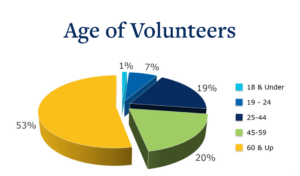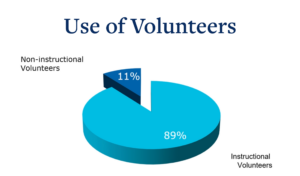Given that a lot of the services adult literacy programs provide are delivered by volunteer tutors and teachers, not to mention the many support roles volunteers have in an organization (fundraising, event planning, marketing, and IT support, among other things) it’s not surprising that recruiting and retaining volunteers is a consistent concern for most program directors.
Today, we’re kicking off a new Volunteer Recruitment and Retention blog series in which we’ll try to understand the barriers to volunteer recruitment and retention and try to answer the big questions:
- How do you recruit good, qualified volunteers? How do you ensure they’ll finish training and take an assignment?
- What if a volunteer can’t commit for one year?
- How do you keep volunteers around for a long time and engage them when there are long periods between assignments?
- Where can you find new and diverse sources for volunteers?
Before we can begin answering these questions, we must first understand who is actually volunteering and why.
Who are our volunteers?


According to ProLiteracy’s Annual Statistical Report, over half of adult literacy volunteers are 60 and older. With so many adults between the ages of 25–59, why do they make up only 39% of our volunteers? Well, just like the students we serve, adults in that age bracket have a lot of things already vying for their time—careers, relationships, taking care of kids and older parents, etc. If we want this age group to volunteer with us, we need to find ways to make it easier for them to fit it into their schedules.
When we think about recruiting volunteers, we typically think about recruiting tutors. This is evidenced by the fact that almost 90% of the volunteers in our member organizations are instructional volunteers. But there’s never been an executive director who has said they have enough staff to do everything else they want to do.
There are many other program needs for non-instructional roles: administrative help, website maintenance and social media monitoring, evaluating new students, event planning, marketing assistance, and more. Maybe we need to consider during volunteer recruitment activities that these might be the roles that might bring the 25–59 age group into your program.
What motivates a volunteer?
When thinking about how to recruit new volunteers into your program, it’s good to take time to consider the general reasons people choose to volunteer:
Values/belief in the cause: I feel it is important to help others be able to …
Personal: I am/know someone who benefits from the organization.
Understanding: Volunteering allows me to learn about the issue through direct, hands-on experience.
Enhancement: Volunteering makes me feel better about myself.
Career: Volunteering helps me get experiences and a foot in the door in a field in which I would like to work.
Social: Volunteering is a chance to meet people who share an interest in community service.
Escape: Helping others is a good escape from my own troubles.
So, to recruit and retain more volunteers, we need to make sure we align volunteer opportunities to their motivations. How do you do that?
Address all the reasons someone might volunteer in your recruiting messages. Often adult literacy and education recruiting messages focus on the impact that learning to read, improving English, or getting a high school equivalency has on an individual and their family. This is great, but we also need to talk about how volunteering gives you the opportunity to meet people, feel good about yourself, or work on your career.
Create volunteer opportunities to match why someone might volunteer in the first place. Make sure there are multiple types of volunteer opportunities that can match the reasons people volunteer. Tutoring is great, but 1-1 tutoring in a library is not a good match for someone who wants to meet new people. That person might be a better fit as an office volunteer or working on a variety of social projects than as a tutor.
Ask volunteers what they want to get out of volunteering with the program. It’s not enough to have a variety of volunteer options, we need to ask people why they want to volunteer and then match them appropriately. If you’re not asking every volunteer that one simple question, then you can’t guide them toward a good volunteer experience. It’s important to also check in regularly to make sure they’re still getting what they wanted from the opportunity. Adjust if necessary.
Break down barriers to volunteering. Two of the biggest reasons people don’t volunteer are because they don’t have the extra time and are unwilling to make a year-long commitment. Considering the data above that volunteers are overwhelmingly used for instruction and many programs ask tutors to commit to meeting with a student at least once a week for a year, we are reinforcing barriers to volunteering instead of breaking them down. Imagine creating an opportunity for an office volunteer to come in once a week to answer phones, call tutors for their monthly reports, and assess new students who come into the program. Imagine they are working with a team of 2–3 other volunteers. Because there’s a team, it’s OK for a volunteer to be out a week now and then because there are others to cover their work. There’s no one person depending on the volunteer, so a year’s commitment isn’t needed. Opportunities like this can be less daunting and can draw in new volunteers to help strengthen your program as support staff.
In the coming months, this blog series will build off these ideas of who our volunteers are and how to motivate them as we discuss the big questions surrounding volunteer recruitment and retention and some solutions.